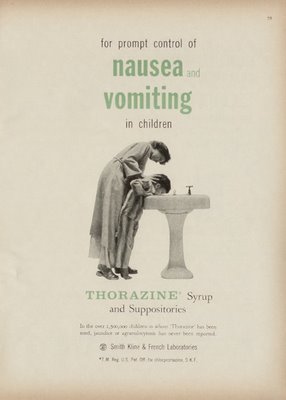Typical antipsychotics (aka.
neuroleptics or major
tranquilizers)
[back]
Toxic Psychiatry
[Wikipedia] Typical antipsychotics (sometimes
referred to as conventional antipsychotics, classical neuroleptics or major
tranquilizers) are a class of antipsychotic drugs first developed in the 1950s
and used to treat psychosis (in particular, schizophrenia), and are generally
being replaced by atypical antipsychotic drugs. Typical antipsychotics may also
be used for the treatment of acute mania, agitation, and other conditions.
Traditional antipsychotics are
broken down into low-potency and high-potency classifications. Fluphenazine and
haloperidol are examples of high-potency typical antipsychotics, and
chlorpromazine is an example of a low potency antipsychotic. High-potency
typical antipsychotics tend to be associated with more extrapyramidal side
effects (EPS) and less histaminic (e.g. sedation), alpha adrenergic (e.g.
orthostasis) and anticholinergic (e.g. dry mouth) side effects, while
low-potency typical antipsychotics tend to be associated with less EPS but more
H1, alpha1, and muscarinic side effects.
See:
Toxic
psychiatry quotes
[2011 Nov] Antipsychotics Linked to
Childhood Diabetes
Antipsychotics Now Top Revenue Producers In US, Topping Cholesterol
Drugs
IMS Health reports that in 2008, sales in the US of antipsychotics (used
for absolutely every alleged mental disorder under the sun) in 2008
reached $14.6 billion, topping lipid regulators (ie, statins, etc.)
which hit $14.5 billion in US sales.
The drugs
Chlorpromazine (Largactil, Thorazine)
Fluphenazine (Prolixin)
Haloperidol (Haldol)
Molindone
Thiothixene (Navane)
Thioridazine (Mellaril)
Trifluoperazine
Loxapine (Loxapac, Loxitane)
Perphenazine
Prochlorperazine (Compazine, Buccastem, Stemetil)
Pimozide (Orap)
Quotes
Since 1954 in the
United States, the administration of one class of twenty psychiatric drugs
called neuroleptics— Thorazine,
Haldol, Mellaril, Stelazine, Prolixin, and
others— has caused between 300,000 and one million cases of motor brain damage.
Rappoport, Jon
(Ownership of All Life)
"The miracle drugs (neuroleptics) cause the worst plague of brain damage in
medical history."--Peter Breggin, M.D.
"I believe more than 1 million Americans suffer from TD. It seems
conservative to say that in 1991, tens of millions of TD victims are alive
around the world…..Psychiatry has unleashed an epidemic of neurological disease
on the world. Even if TD were the only permanent disability produced by these
drugs, by itself, this would be among the worst medically-induced disasters in
history."—Peter Breggin, M.D.
"The risk of developing severe TD from antipsychotic drugs probably lies between
20% and 40%, but mild symptoms appear in up to 70% of patients."—Jack Gorman,
Essential Guide to Psychiatric Drugs, 1990.
Thorazine was used regularly at the CIA’s
Jonestown
,
Guyana
group control experiment. Survivors of Jonestown have testified as to its
effectiveness. After this gruesome experiment in mind control came to its end
with a massacre, large amounts of drugs were discovered. Just one footlocker at
Jonestown alone contained 11,000 doses. The authorities prevented chemical
autopsies of the bodies to insure secrecy of this sophisticated concentration
camp which was used for medical and psychiatric experimentation by the CIA. An
examination of the drugs that are used in mental hospitals to alter the minds of
patients offers a clear indication of what is being used in the Monarch Mind
Control programming. The Illuminati Formula
3. THE USE OF DRUGS
AFFIDAVIT OF ROBERT WHITAKER
In summary, the research literature reveals the
following:
a) Antipsychotics increase the likelihood that a person will become chronically
ill.
b) Long-term recovery rates are much higher for unmedicated patients than for
those who are maintained on antipsychotic drugs.
c) Antipsychotics cause a host of debilitating physical, emotional and cognitive
side effects, and lead to early death.
d) The new "atypical" antipsychotics are not better than the old ones in terms
of their safety and tolerability, and quality of life may even be worse on the
new drugs than on the old ones.
Articles
Psychiatric Drugs Shorten Life Span By
Samuel A. Moser
